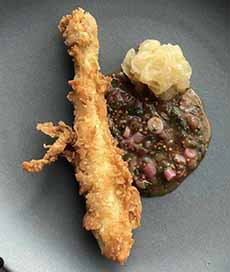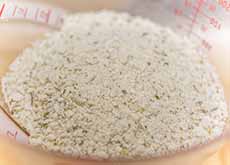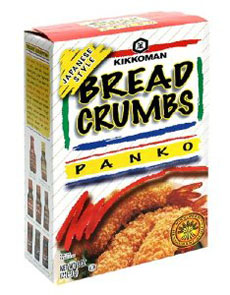FOOD FUN: Panko-Coated Oven Fried Vegetables, A Yummy Recipe
|
|
We were going to say “Southern Fried Veggies” instead of Panko Oven Fried Vegetables, but Southern fried chicken uses seasoned flour. Here, we’re using panko breadcrumbs [photos #3 and #4]. There’s more about panko below. This article was inspired by Vicia Restaurant in St. Louis—and their yummy panko-coated vegetables, in photos #1 and #2. The restaurant celebrates the elevation of vegetables from conventional recipes to exciting ones. We can hardly claim the level of know-how and skill as the chefs at Vicia, but we created our own version of the recipe, with a major difference: We’ve cut back on fried foods; so we baked the vegetables instead. You can use this recipe with other vegetables, too. Ingredients 1. PREHEAT the oven to 425°F. Spray a rack and baking pan with nonstick spray and put on the middle rack. 2. SEASON the panko with salt and pepper, as desired (if you are using seasoned panko, don’t add extra seasoning). 3. SET up the flour, eggs and panko on three separate shallow bowls or plates. Working in batches… 4. DREDGE the asparagus in flour, then dip into the beaten eggs, then dredge heavily in panko mixture, pressing the asparagus into the panko to coat well. 5. PLACE the asparagus onto the baking sheet in a single layer. Bake for 10-12 minutes, or until they are golden brown. If the asparagus brown too quickly, through, tent with foil. 6. SERVE immediately. Panko is a terrific coating for fried chicken, although our personal favorite chicken coating is the crunchier Corn Flakes. Panko is actually bread “flakes” rather than breadcrumbs. The difference is that conventional bread crumbs are ground into tiny bits, while panko are small flakes. However, companies that sell them in the U.S. call them breadcrumbs, so as not to confuse customers. They allow foods to stay crispier longer. You can buy panko in the Asian products section in most markets. Panko are made from specially baked, oblong, crustless loaves. The larger and lighter flakes that are produced coat the food without “packing down” like regular bread crumbs. Panko can be used with baked or fried foods and with sweet products too (panko-fried Oreos, anyone?). You can find seasoned and unseasoned panko. And you can use panko for many things, including French toast. Check out these recipes from Kikkoman. In 1543, Portuguese merchant ships initiated the first contact with Japan. There began a cultural exchange with the traders and European missionaries, and among other things, the Japanese learned to bake bread. |
|
|
It is believed that it these Europeans introduced deep fat frying to the Japanese, as there is no mention of oil in cooking prior to the Portuguese landing in Japan. This ultimately led to tempura, tonkatsu, and other fried Japanese foods we now enjoy [source]. Western culture began to be become prominent during the Meiji Era, a 44-year period from 1868 to 1912. Restaurants in major towns began to provide Western-style cuisine, including foods that were coated in breadcrumbs, such as croquettes and fried fish. Most of the breadcrumbs of the time were made from crushed biscuits and crackers, which were very expensive. Chefs, started to use sliced bread to make breadcrumbs. After the loaves are air-dried overnight, a special food processor cuts them into long crumbs, or flakes. These were different from the tiny European-style crumbs, made by grinding the dried bread [source]. |
||







